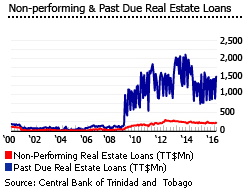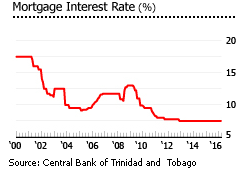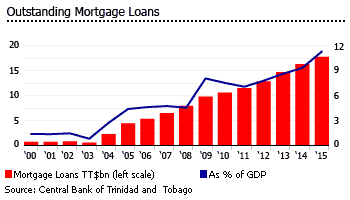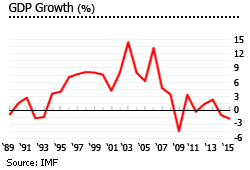Trinidad and Tobago's property prices are now rising modestly
 In 2015, residential property prices in Trinidad and Tobago rose by about 6%, according to Patricia Phillips of Island Investments Company Ltd. However Phillips noted that “the market is still on the road to recovery, and it’s still a buyer’s market.”
In 2015, residential property prices in Trinidad and Tobago rose by about 6%, according to Patricia Phillips of Island Investments Company Ltd. However Phillips noted that “the market is still on the road to recovery, and it’s still a buyer’s market.”
Property prices fell 20% from 2007 to 2009 due to the global crisis. Trinidad and Tobago’s property prices started to rise again in 2014, after a lacklustre performance over the past several years, according to the Association of Real Estate Agents (AREA).
The country did not recover as quickly as some Caribbean nations mainly due to a government mandate issued in 2007 requiring foreign investors to obtain a license for all land purchases in Tobago. Foreign homebuyers, who mostly come from Britain, Germany, the United States and Canada, declined sharply. The problem was exacerbated by the global crisis, according to Walter Zephirin of Seventh Heaven Properties.
House prices in the islands range from around TT$1.5 million (US$240,000) to TT$8 million (US$1.26 million), depending on size, location and amenities - though of course there are super-luxurious and also low-end houses that fall well outside this range.
In Trinidad, the price of three-bedroom single-storey home starts at around US$310,000 in January 2016, according to Sarah Joseph, a real estate broker with Sunrise Properties. In the more desirable neighborhoods of West Trinidad, modern homes are priced from about US$550,000.
At The Crossings, located on the outskirts of the bustling town of Arima in Trinidad, three bedroom houses are currently being offered from around TT$1.76 million (US$265,000) to TT$2.2 million (US$330,000). On the other hand, residential land in The Crossings sells for less than TT$120.5 (US$19) per square foot (sq. ft.).
In Tobago, the price of small condominiums starts at around US$390,000 while single-family homes start at about US$550,000.
Despite improving conditions, falling oil prices may hinder a full-scale recovery of the housing market this year, according to local real estate experts. The economy is largely dependent on the country’s large oil and gas reserves, particularly in Trinidad.
In 2015, the economy contracted by 1.8%, after falling 1% in 2014. Before that, there was growth of 1.7% in 2013 and 1.4% in 2012. The economy is projected to contract again by 1.1% this year, according to the International Monetary Fund (IMF).
Housing boom and bust

Trinidad and Tobago saw a massive housing boom from 1991 to 2006, with house prices surging by more than 400%, amidst strong construction activity, high oil prices and a flourishing petrochemicals sector. Foreign investment poured in. Much new private housing was built in Port of Spain, in the northwest region, and the area around Point Lisas Industrial Estate, the centre of Trinidad and Tobago’s petrochemical industry.
As the global economic recession set in, demand fell sharply. Projects were completed or halted. Foreign investment fell, and unemployment rose – reaching almost 6% in 2010. Financial and investor confidence also tumbled when CL Financial, Trinidad and Tobago’s largest privately-held conglomerate (and one of the largest in the Caribbean), collapsed due to high leverage and risky investments, and had to be rescued by the government.
Then the government introduced a new property tax – a 3% tax rate on residential property and a 5% tax rate on commercial property, based on 90% of annual rentable value. This aroused a lot of anger. After the victory of new PM Kamla Persad-Bissessar, elected in May 2010, the reform was suspended by the new People’s Partnership-led coalition government. The previous Lands and Buildings Taxes Act rates and values were reintroduced.
Property prices fell by about 20% from 2007 to 2009 due to the global crisis. Not until 2014 did the market substantially improve. Demand is now slowly coming back. Construction activity is increasing. House prices are now rising again.
Mortgage interest rates unchanged

From a high of 17.5% in January 2000, the average mortgage interest rate dropped to 9.13% in February 2005, fuelling the country’s massive housing boom. However, benchmark interest rates were then raised, which caused the mortgage rates to follow, reaching 13% in October 2008.
Interest rates were reduced several times after 2009, and both the basic prime rate and the average mortgage rate fell to 7.5% in November 2012, according to the Central Bank of Trinidad and Tobago. Today the average mortgage interest rate remains unchanged at 7.5%.
The central bank’s repo rate was 4.75% in the first quarter of 2016, unchanged from the previous quarter but up from just 3.75% in the same period last year. On the other hand, the basic prime lending rate of commercial banks increased to 9% in Q1 2016, from 8.93% in Q4 2015 and 7.75% in a year ago.
Mortgage market problems
Trinidad and Tobago’s mortgage market has expanded rapidly in the past decade. Mortgage loans outstanding surged by an annual average of 45% from 2004 to 2015. From just roughly about 0.8% of GDP in 2003, the size of the mortgage market expanded to 11.3% of GDP in 2015.

In February 2016, the total amount of mortgage loans outstanding rose by 8.3% from the same period last year, to TT$17.9 billion (US$2.69 billion), according to the Central Bank of Trinidad and Tobago.
An increasing number of homeowners are now struggling to pay their monthly mortgage payments. In February 2016, the total past due real estate loans climbed by 92.3% y-o-y to TT$1.5 billion (US$225.4 million), according to the Central Bank of Trinidad and Tobago. Likewise, the total amount of non-performing real estate loans in commercial banks rose to TT$231.6 million (US$34.8 million) in February 2016, up by 6% from a year earlier and about 5.5 times higher than in the pre-crisis year of 2008.
The expat rental market
Trinidad and Tobago’s upscale neighbourhoods, mostly in the West region, became popular with expats during the housing boom, and commanded high rentals. However, the economic downturn caused an outflow of these foreign renters. As a result, rents for a large number of properties fell substantially. However in 2015, residential rents have stabilized.
For the expatriate and upper-income markets, there is a wide range of residential rents - from TT$9,514 (US$1,500) to TT$95,142 (US$15,000) per month at end-2015.
For the local market, more particularly the middle income market, residential rents for apartments and properties in gated communities typically range from TT$3,000 (US$473) to TT$20,000 (US$3,153).
Some of the most attractive locations to rent or buy in Trinidad are:
Westmoorings – upscale Port of Spain suburb, with high-rise apartment complexes
Goodwood Park – exclusive neighbourhood near Port of Spain, with large private houses
Bayside Towers – new luxurious apartment complex
The Greens, Maraval Valley – modern, luxurious gated community
The economy continues to struggle

Trinidad and Tobago is one of the Caribbean’s richer nations. The island of Trinidad is world-famous for the Trinidad Carnival, but unlike many of its Caribbean neighbours, which rely on tourism, Trinidad depends heavily on oil and gas production. The energy sector accounts for more than 40% of GDP and 85% of merchandise exports. Its sister island Tobago, which has a wealth of secluded beaches and rainforests, benefits from the larger island’s prosperity.
However wealth does not bring immunity from recession. In 2009 Trinidad and Tobago’s GDP contracted by 4.4%, followed by a 0.1% contraction in 2010. There was recovery in 2012 with 1.4% GDP growth and 1.7% growth in 2013. However, the economy contracted again by 1% in 2014 and by another 1.8% in 2015. The economy is projected to contract again by 1.1% this year before expanding by 1.8% in 2017, according to the International Monetary Fund (IMF).

In March 2016, the country’s overall inflation rate stood 3.3%, from 3.4% in the previous month and 6.6% from a year ago, according to the Central Statistics Office, according to the IMF. Inflation is expected to be 4.1% this year.
The construction industry is getting a boost from the government’s development plan “Vision 2020”, which consists mainly of construction projects.
In the past several years, the government has prioritized economic diversification, focusing its efforts not just in the energy sector, but also in the non-energy sector and services sector.
Challenge for new government - fighting corruption, reducing crime
During the September 2015 general elections, the opposition People’s National Movement (PNM) led by Keith Rowley won 23 seats of the 41-seat parliament, ousting the incumbent ruling United National Congress led by Mrs Kamla Persad-Bissessar, the former lawyer who became the country’s first woman Prime Minister in 2010. Persad-Bissessar captured the remaining 18 seats.
The current Prime Minister Keith Rowley is now facing pressures to fight corruption and reduce crime. Moreover, he also needs to make tough budget decisions over spending on social programs due to lower oil prices.
While many local residents in Trinidad and Tobago are prosperous, 17% of the population lives below the poverty line. Crime involving drugs, guns, and gangs remains a challenge, particularly in Trinidad, with murders and kidnappings topping the list.
Buying property
In Trinidad, foreign real estate buyers can buy up to one acre of property for residential use without a license. In Tobago, by contrast, no license has been issued to foreign buyers since a requirement for licenses was introduced in October 2007.
Buyers are required to pay 5% to 10% stamp duty, plus legal fees.